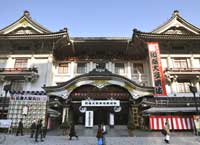|
THE NEW WAVE OF TRADITIONAL THEATER
Kabuki Energized by Infusion of Talent from Other Genres
(March 4, 2008)
|
|
Kabuki, known throughout the world as a quintessentially Japanese traditional art form, can be traced back some 400 years, during which it has spawned countless fine stage works. Because Kabuki is considered "classical" theater, some may be inclined to think of it as a fossilized art form, but nothing could be further from the truth. Kabuki has a long history of skillfully incorporating contemporary trends as it developed and matured as a performing art, maintaining at all times a spirit of "anything goes." That spirit is alive and well in the twenty-first century, most recently taking the form of works staged in collaboration with writers and directors of contemporary theater. This seemingly incompatible "oil and water" combination has given rise to a number of exciting new works and has breathed new life into a classical form. Popular Guest Directors The next major collaborative work was Ninagawa Juniya (2005), a Kabuki version of Shakespeare's Twelfth Night by the internationally renowned director Ninagawa Yukio, known for such adaptations as Ninagawa Macbeth. Next, in 2006, came an original Kabuki play titled Ketto! Takadanobaba (Duel in Takadanobaba), written and directed by Mitani Koki, whose earlier play Warai no Daigaku (University of Laughs) has been successfully adapted for the London stage as The Last Laugh. Mitani's Ketto! Takadanobaba has helped broaden Kabuki's fan base by bringing in younger audiences than those Kabuki has typically attracted. Of particular interest is the fact that each of these plays was conceived not by their production company, Shochiku (the film and theater giant that owns and operates Tokyo's Kabuki-za theater), but by individual Kabuki actors. Approaching the directors personally and shepherding the projects through to realization were Nakamura Kanzaburo in the case of Togitasu no Utare, Onoe Kikunosuke for Ninagawa Juniya, and Ichikawa Somegoro for Ketto! Takadanobaba. In a sense, each of these fine works was the brainchild of an actor in search of exciting new material. Kabuki as a Matrix for New Genres |
Copyright (C)2008 Web Japan. Edited by Japan Echo Inc. based on domestic Japanese news sources. Articles presented here are offered for reference purposes and do not necessarily represent the policy or views of the Japanese Government.

